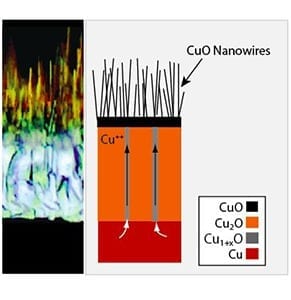
Working on dye-sensitized solar cells – researchers from University Malaya (UM) and National Tsing Hua University (NTHU) have achieved an efficiency of 1.12 %, at a fraction of the cost compared to those used by platinum devices.
This work has been accepted for publication in the journal, Nanoscale published by the Royal Society of Chemistry and has been selected for the front cover of the issue.
The study carried out in Taiwan took on the challenge of making the technology behind dye-sensitized solar cells more affordable by replacing the costly platinum counter-electrodes with bismuth telluride (Bi2Te3) nanosheet arrays.
Using a novel electrolysis process, the group managed to closely manipulate the spacing between individual nanosheets and hence control the thermal and electrical conductivity parameters to achieve the high efficiency of 1.12%, which is comparable to platinum devices, but at only at a fraction of the cost.
The research was led by Prof. Yu-Lun Chueh of the Nanoscience & Nanodevices Laboratory, NTHU, and Alireza Yaghoubi, UM HIR Young Scientist. “In light of the recent report by the United Nations about the irreversible effects of fossil fuels on climate change and as we gradually run out of economically recoverable oil reserves, we think it is necessary to look for a sustainable, yet practical source of energy” Yaghoubi stated.
Meanwhile at University Malaya, Dr. Wee Siong Chiu and colleagues were working on controlling the secondary nucleation and self-assembly in zinc oxide (ZnO), a material which is currently being scrutinized for its potential applications in dye-sensitized solar cells as well as photocatalytic reactions to generate clean electricity by splitting water under sunlight.
In this work, Dr. Chiu and Alireza Yaghoubi demonstrated a new route for synthesis of various zinc oxide nanostructures using the lipophilic interactions between a novel precursor and a number of fatty acids. They are hoping to further use this method to increase the efficiency of photocatalysts in the visible regime where most of the sunlight energy lies.
According to the researchers, if this approach is successful, generating electricity is as easy as pouring some bioinert nanomaterials into a lake and fusing the split oxygen and hydrogen atoms back into water in a photoelectrochemical cell.
The Latest on: Dye sensitized solar cell
[google_news title=”” keyword=”Dye sensitized solar cell” num_posts=”10″ blurb_length=”0″ show_thumb=”left”]
via Google News
The Latest on: Dye sensitized solar cell
- How Do Solar Panels Work?on April 26, 2024 at 5:00 pm
Another fun solar power technology is the dye-sensitized solar cell. These flexible cells use a photoreactive dye mixed with semiconductor nanoparticles as the top layer. Usually, that mixture ...
- This Swedish startup made the tech behind the world’s first solar-powered headphones – here’s how it workson April 22, 2024 at 11:36 am
"Powerfoyle is based on a lab scale discovery called 'dye-sensitized solar cells', which we have both reinvented and scaled to match the demands of global companies like 3M, adidas and Vusion Group.
- Making A Dye-Sensitized Solar Cell Is Almost DIY-ableon February 28, 2024 at 12:45 pm
The project consists of a large dye-sensitized solar panel ... etched and prepared to become the electrodes for a string of solar cells. The cells have to be treated with titanium dioxide and ...
- Yuri Dahnovskyon November 12, 2023 at 2:00 pm
tunneling microscopes and dye sensitized solar cells. There is also ongoing work on the physical and chemical properties of adsorbed molecules on metal surfaces in organic electronics.
- Numerical Analysis Using Ron September 13, 2023 at 5:30 am
MALDON, BENJAMIN LAMICHHANE, BISHNU PRASAD and THAMWATTANA, NGAMTA 2021. NUMERICAL SOLUTIONS TO A FRACTIONAL DIFFUSION EQUATION USED IN MODELLING DYE-SENSITIZED SOLAR CELLS. The ANZIAM Journal, Vol.
- About the Editorson May 10, 2023 at 11:38 am
Her postgraduate Master in Materials for Energy took her to Solaronix, Switzerland, where she worked on dye-sensitized solar cells. She later obtained her PhD in Physics from University College ...
- Dr Natalia Martsinovichon April 23, 2022 at 9:47 am
Photovoltaics uses solar cells to convert solar energy into electricity. Several types of solar cells have been developed; the current market leaders – silicon solar cells – are efficient but ...
- Making Solar Cellson January 3, 2018 at 9:19 pm
We will admit that it is unlikely you have enough gear in your basement to make a solar cell using these steps. However, it is interesting to see how a bare silicon wafer becomes a solar cell.
- Prof Jianyong Ouyangon February 9, 2015 at 10:13 am
His lab has been particularly interested in developing novel methods to process nanotubes and nanoparticles and application of these nanometer materials in electronic devices, such as ...
via Bing News










